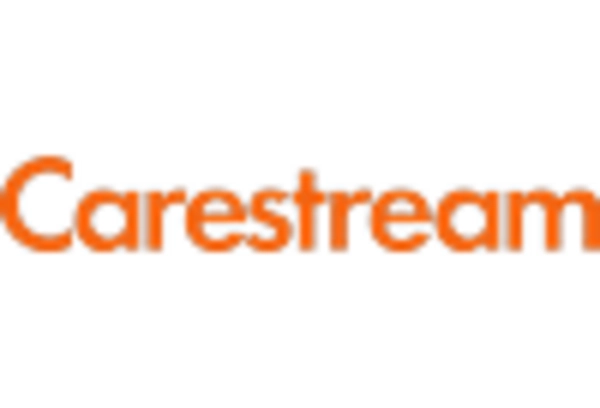Growing Adoption of Telemedicine
The Computed Radiography Market is benefiting from the growing adoption of telemedicine, which has transformed the way healthcare services are delivered. As telemedicine becomes more prevalent, the need for efficient and high-quality imaging solutions is increasing. Computed radiography systems facilitate remote consultations by providing high-resolution images that can be easily shared with specialists. This capability is particularly valuable in rural and underserved areas where access to healthcare is limited. The integration of computed radiography with telemedicine platforms enhances the overall patient experience and improves diagnostic outcomes. As telemedicine continues to expand, the Computed Radiography Market is expected to grow in tandem, driven by the demand for remote imaging solutions.
Increased Focus on Patient Safety
The Computed Radiography Market is witnessing a heightened focus on patient safety, which is influencing the adoption of advanced imaging technologies. Healthcare providers are increasingly prioritizing methods that minimize radiation exposure while maintaining diagnostic quality. Computed radiography systems are designed to optimize image quality with lower doses of radiation, aligning with safety protocols and regulations. This emphasis on patient safety is not only a response to regulatory requirements but also a reflection of the growing awareness among patients regarding the risks associated with radiation. Consequently, the Computed Radiography Market is likely to see a rise in demand for systems that prioritize safety without compromising diagnostic efficacy.
Rising Incidence of Chronic Diseases
The Computed Radiography Market is significantly influenced by the rising incidence of chronic diseases, which necessitates advanced diagnostic imaging solutions. Conditions such as cancer, cardiovascular diseases, and respiratory disorders require precise imaging for effective management and treatment. According to recent statistics, the prevalence of chronic diseases is on the rise, leading to an increased demand for diagnostic services. This trend is prompting healthcare facilities to invest in computed radiography systems that offer quick and accurate imaging capabilities. As the need for early detection and monitoring of chronic conditions grows, the Computed Radiography Market is poised for substantial growth, driven by the demand for reliable imaging technologies.
Technological Innovations in Imaging Systems
The Computed Radiography Market is experiencing a surge in technological innovations that enhance imaging systems. Advancements in digital imaging technology, such as improved image processing algorithms and high-resolution detectors, are driving the demand for computed radiography solutions. These innovations not only improve diagnostic accuracy but also streamline workflow in healthcare settings. The integration of artificial intelligence in imaging systems is also noteworthy, as it aids in image analysis and interpretation, potentially reducing the time required for diagnosis. As healthcare providers seek to adopt cutting-edge technologies, the Computed Radiography Market is likely to benefit from increased investments in advanced imaging solutions, thereby expanding its market share.
Regulatory Support for Advanced Imaging Technologies
The Computed Radiography Market is positively impacted by regulatory support for advanced imaging technologies. Governments and health organizations are increasingly recognizing the importance of modern imaging solutions in improving healthcare outcomes. Initiatives aimed at promoting the adoption of advanced diagnostic tools are being implemented, which encourages healthcare facilities to invest in computed radiography systems. Regulatory bodies are also establishing guidelines that ensure the safety and efficacy of imaging technologies, further bolstering confidence among healthcare providers. This supportive regulatory environment is likely to stimulate growth in the Computed Radiography Market, as more facilities seek to comply with standards while enhancing their diagnostic capabilities.


















Leave a Comment